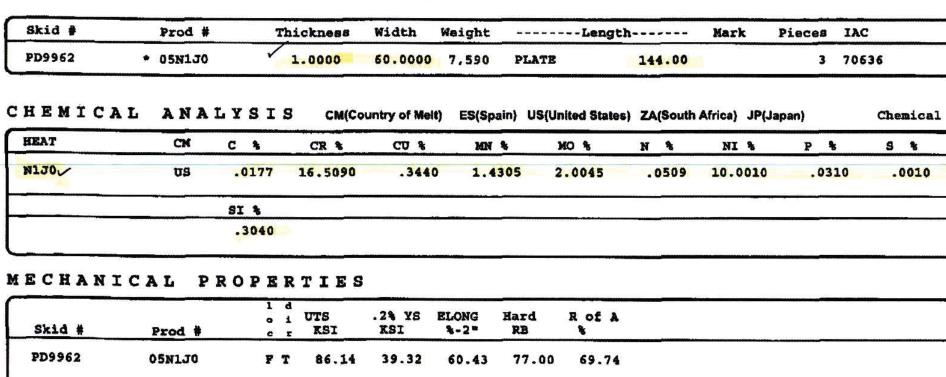What is Material Test Report (MTR)/ Mill Test Report?
Material test report or Mill test report certifies that the chemical analysis and mechanical properties are in conformance with the specified specification.
An MTR certifies a material’s compliance with the standard specification such as ASME Section II Part A and B or ASTM. The MTR is supplied from the material manufacturer such as plate manufacturer, casting manufacturer, forging manufacturer, etc.
Material Test Report review requirement is covered in I4I Academy Source Inspection training courses.
Heat Number
The MTR document contains heat number which is also known as “melt number” and is similar to lot or batch number. When the steel plate is in its molten condition, a sample is drawn out from the batch for analysis of its chemical composition. This plate is given a particular identification number known as heat number.
The heat number provides a way to trace back the steel plates to its production units and process conditions. During the inspection of the material the heat number mentioned on the MTR must match with one on engraved/printed on the plate.
Several plates might have identical heat number, and this is normal since that indicates both plates made from the same batch of melted material.
Contents of Material Test Report
An MTR certificate contains following information in general.
- Basic information such as name of the material manufacturer, material size, weight, material identification and grade i.e. SA 516 Gr. 70, ASTM A106 Gr 60
- Material Heat Number
- Chemical composition analysis test result
- Mechanical test result
How to review an MTR?
Assume you have assigned for inspection of pressure vessel plate material at the pressure vessel manufacture shop. The vessel manufacturer provides you with MTR for purchased plate material from his supplier.
You look at the pressure vessel drawing and find out the vessel plate should be SA240 TP 316 L (Low Carbon Stainless Steel).
Following MTR provided to you. This is just for example; the MTR header has been removed.

Step 1
You will walk on the shop floor and make a visual inspection. You should see the stenciled heat number on the plate surface which in this MTR is “N1J0”. With this checking, you make sure your MTR is the one generated for this plate. (Based on the project requirement, you might also run a visual inspection on plate edges, plate surface and also make dimensional inspection especially thickness measurement)
Step 2
You will open the ASME Section II Part A and find SA 240 TP 316 L material specification. Locate the chemical composition table and compare the percentage values in the MTR with the acceptance range in the table e.g. Carbon (C), Chromium (Cr), Cupper(Cu), Manganese (Mn), Molybdenum(Mo), Nitrogen (N), Nickel(Ni), phosphor(P), Sulphur(S) and silicon(Si).
Step 3
Locate the mechanical property table in the same specification. It generally comes after chemical composition table. Similarly, compare the measured value in the MTR with the acceptance range in the mechanical properties table.
For this example, you need to check yield strength, tensile strength, elongation, reduction in area and hardness
If the result of all verification on all these 3 steps were satisfactory, then the result of MTR review will be satisfactory. The material test report review in most of ITP’s is the “Review” point.
MTR based on EN 10204 Standard
When you review the project specification even the inspection and test plan occasionally you might see that project requires the material test report being provided either in conformance with EN 10204 3.1 or EN 10204 3.2
EN 10204 3.1
The material certificate is provided and certified by the material manufacturer. So when you review the MTR with this requirement, you only see the material manufacturer stamp/signature
EN 10204 3.2
Besides, material manufacturer an independent inspection agency also shall authenticate the MTR. You typically need to see two stamps and signatures, one from the material manufacturer and the second one from inspection agency.
The inspection agencies usually assign an inspector to witness the chemical composition analysis test and mechanical testing. The third party inspector verifies test result with acceptance criteria and also checks heat numbers and test specimens. If all items met the requirements, the inspector would sign off the MTR.
Free newsletter!
Sign up to receive my monthly newsletter covering all the latest courses and updates.




New! Comments
Have your say about what you just read! Leave me a comment in the box below.